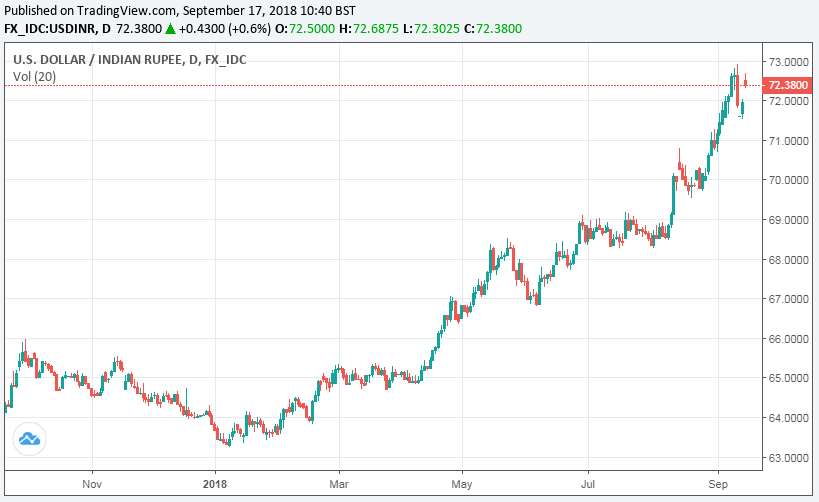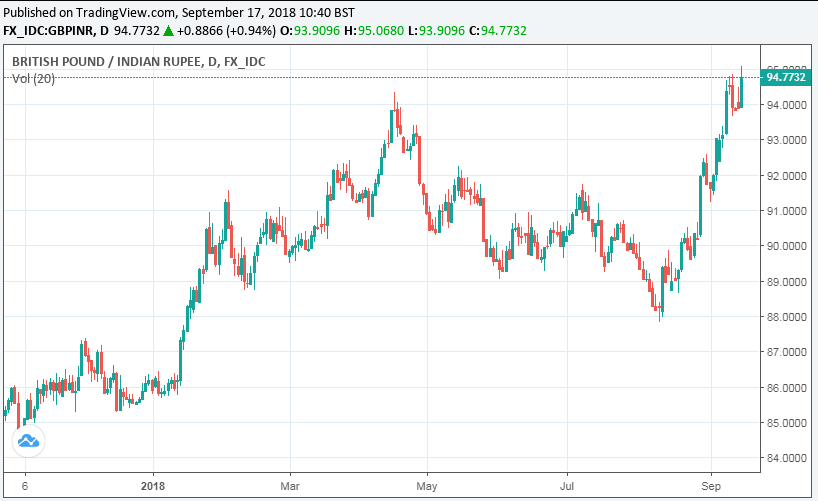Rupee Remains on Back Foot Despite Capital Controls, Now Asia's Worst Performer
- Written by: James Skinner
-

© Ash T Productions, Adobe Stock
- INR slides again after government announces import controls.
- Analysts say restrictions do not address oil imports, won't work.
- Further pressure on INR anticipated, more RBI rate hikes required.
The Rupee could be on course for new lows according to some analysts, as pressure on the current account deficit mounts despite the Indian government having taken a range of measures designed to stem an exodus of capital from the country and support the currency.
India's government said Friday it will take action to stem an increase in its current account deficit, which is expected to widen in 2018. Action comes as the currency trades at a 13% loss against the US Dollar for the 2018 year and a 10% loss against Pound Sterling.
The Rupee has repeatedly set new record lows in September and is now Asia's worst performing currency for 2018.
The government will soon begin restricting imports of some "nonessential items" in order to lessen the number of Rupees being sold on international markets in order to fund the purchase of goods from overseas, according to Finance Minister Arun Jaitley. The late-Friday announcement prompted fresh losses for the Rupee on Monday.
“One broad policy decision was to address the issue of expanding current account deficit. The government will take necessary steps to cut down non-essential imports and increase exports,” says Jaitley, at a press conference following a meeting of officials in New Delhi Friday.
Government will also relax rules relating to foreign ownership of corporate bonds and scrap withholding tax on local currency bonds.
"It’s hard to imagine these measures being immediately effective in curbing the currency depreciation, as the external payments situation remains on a deteriorating path. Today's market reaction testifies to this. As such, more measures are expected," says Prakash Sakpal, an economist at ING Group.

Above: USD/INR rate shown at daily intervals.
The Pound-to-Rupee rate was quoted 1.08% higher at 94.9 Monday while the USD/INR rate was 0.83% higher at 72.46.

Above: Pound-to-Rupee rate shown at daily intervals.
Trade War, Fed and Deficits in Focus
India's current account deficit widened to $15.8 billion during the first quarter, from $15 billion for the final three months of 2017, which is equivalent to around 2.4% of GDP. Most economists expect that it will have widened again during the second quarter, although data covering that period will not be released until later in September.
The nation's trade deficit widened to $18.02 bn during July, up from $11.45 bn in the same period one year before. This means the value of Rupees sold on international markets in order to buy other currencies and pay for imports has increased substantially in 2018, which is also partly a symptom of India's fast growing economy.
"Notably no measures were announced to reduce oil imports and in the absence of a major drop in oil prices, pressure on the current account will remain. New measures such as tapping non-resident Indian deposits and a possible rate hike by the RBI could be announced in the weeks ahead," says Mitul Kotecha, an emerging market strategist at TD Securities.
Trade and current account deficits reflect not only real world supply and demand for a currency, but also the extent to which a nation's government is financed by borrowings from the rest of the world.
Jaitley told reporters that India's current account problems have roots in the 17% or so rise in the price of oil this year, as well as President Donald Trump's "trade war" with China.
"We think the announced measures are likely to help provide further support to the INR over the short term, especially given the current background of slightly better EM sentiment. Further out, more INR depreciation, albeit at a less rapid pace, is likely as the external environment remains challenging for current account deficit countries," says Kotecha.
President Trump's trade war with China has heaped more pressure onto emerging markets by stoking fears for the Chinese economy and driving capital flows into the safe-haven US Dollar at a time when the greenback was already riding high thanks to a roaring economy and hawkish Federal Reserve interest rate policy. This has pressured the Rupee.
Fed policy, as well as Trump's tax reforms, hoovered US Dollars from the international financial system and made the greenback more expensive to borrow and buy on international markets. This too has pressured the Rupee because it has made Indian foreign currency debt more expensive to service.
More RBI Rate Hikes on Way
Nonessential items to be the subject of import restrictions will be announced over coming days, although TD's Kotecha and ING's Sakpal are not the only analysts who are sceptical of whether they will be able to prevent a deterioration of the current account deficit and stem the Rupee depreciation.
"We believe USD/INR will stay in the 70s, with the risk of overshooting our 72 forecast, depending upon the timing of composition of measures to slow down INR weakness introduced. With oil prices reaching fresh highs and local concerns (election risk, fiscal slippage and reserve depletion) still present, the fundamental headwinds are unlikely to recede soon," says Kamal Sharma, an FX strategist at Bank of America Merrill Lynch.
Sharma and the Bank of America team forecast the USD/INR rate will trade around 72 until year-end before declining to 70 in time for the end of 2019. They project the Pound-to-Rupee rate will decline to 94.38 in 2018 before rising to 98.59 in 2019.
Beyond addressing goods imports, one of the few but effective options available for Indian policymakers to address deficits would be for them to raise interest rates again. The Reserve Bank of India has lifted its base rate by 50 basis points to 6.5% in 2018, but Kotecha, Sharma and others are anticipating at least one more move before the year is out.
This might help the Rupee, and thereby reduce the trade and current account deficits, given changes in interest rates impact currencies because of the push and pull influence they have on international capital flows and their allure for short-term speculators. The Capital Economics team predict Indian interest rates will rise to 6.75% in 2018.
"Investors may start pricing in more aggressive tightening in India after recent measures failed to stem the currency weakness. But we're in no rush to change our forecast of two more 25 basis points central bank policy rate hikes at the October and December meetings, or a USD/INR rate of 73.50 by end-2018," says ING's Sakpal.
Advertisement
Get up to 5% more foreign exchange by using a specialist provider to get closer to the real market rate and avoid the gaping spreads charged by your bank when providing currency. Learn more here






